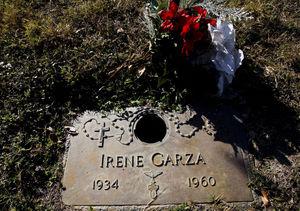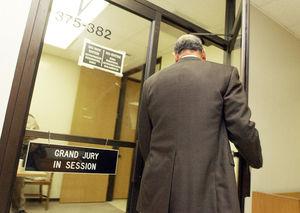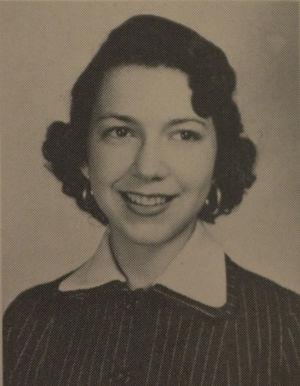|
Irene Garza's family feels weight has been lifted as former priest faces murder charge
By Kristian Hernandez And Lorenzo Zazueta-Castro
EDITOR’S NOTE: In Monday's edition, former priest Dale Tacheny details in a taped interview with The Monitor John Feit’s confession to Irene Garza’s murder. EDINBURG — Noemi Sigler stood over her cousin Irene Garza’s grave Friday and felt the weight of a decades-long fight to bring the young woman’s killer to justice had finally been lifted from her shoulders, she later said. “You can’t even imagine. I had so many doors closed in my face, and I would often get so discouraged,” said Sigler, who for the past 32 years tirelessly pressed law enforcement to get the man who killed her cousin. “Many times I would try to stop and I’d try to leave it alone, but Irene would always bring me back,” she added. But in a stunning development last week, Sigler’s efforts finally seemed to pay off as news broke that the man she believes killed her 25-year-old cousin the night before Easter in 1960 had been arrested in Arizona. John Feit, 83, the man long suspected by many of killing Garza, a McAllen beauty queen, more than five decades ago remains in custody of the Maricopa County Sheriff’s Office, where he could be for several more months. Feit stood before Maricopa County Superior Court Commissioner Paula Williams on Wednesday and was explained his options, ultimately deciding to contest his extradition from Arizona to McAllen. Feit, who was arrested at his apartment in Scottsdale a day before, had lived in the Phoenix area since the early ‘80s, where he had started a new life after leaving the priesthood, but never quite shaking off the suspicions by law enforcement about his involvement in Garza’s death. He told Williams that he did not understand why he was being arrested more than five decades after he was initially accused. The commissioner said there is no statute of limitations on murder charges. “It almost sounds as though waiving extradition is a better course. But this whole thing doesn’t make sense to me because the crime in question took place in 1960,” Feit said. “In 2003, the same gentlemen were here, and questioned me extensively, and (took) a DNA sample — that was 13 years ago. I’m totally puzzled why something is coming up now, after the fact.” After his decision to fight extradition, Williams set a $750,000 cash-only bond and remanded Feit back to jail. Feit is scheduled back in a Phoenix courtroom Feb. 24 for his extradition hearing. This was not the first time Feit went before a judge accused of attacking a young devout Catholic woman. On the night of March 23, 1960, Maria America Guerra, a 19-year-old Pan American College student, was attacked from behind as she knelt praying the rosary inside Sacred Heart Church in Edinburg, where Feit was a visiting priest, according to court records. “He grabbed me and tried to stuff a rag in my mouth, and I started fighting back,” Maria testified during a March 1962 trial. “He grabbed me down towards the floor and kept me down with his hands on my mouth.” Maria, who pointed Feit out in court, said in an effort to escape the priest, she bit down on his finger and screamed. The trial, which was held in Austin district court after Feit’s attorney asked for a location other than Hidalgo County due to the “unusual publicity and notoriety” the case had received, was the second trial after the first one the fall before resulted in a hung jury when it failed to reach a verdict. The Austin district attorney recommended that a “substantial fine” be imposed because the attack occurred during “a most solemn moment.” Feit, who was indicted on assault with intent to rape, pleaded no contest to a lesser charge of aggravated assault — then considered a misdemeanor — and was ordered to pay a $500 fine and $27.90 in court costs. In a prepared statement after the trial, Feit’s attorney Fred Semaan said the trial had taken a toll on his client. “The ordeal of the accusation itself, the ordeal of the first trial, and the fact that this matter has been pending for so long has had an unfavorable effect on Father Feit’s nervous system,” Semaan said in the statement. “His only desire at this time is to regain his health and return to his duties as quickly as possible. Father Feit holds no malice toward anyone, and is glad that the matter is closed.” Maria’s attack happened three weeks prior to Garza’s disappearance and, despite the similarities between both cases, Feit never faced a court in connection with Garza’s slaying, in which law enforcement also believed she had been raped. Garza left her home for the last time about 6:45 p.m. April 16, 1960, the night before Easter. The 25-year-old second-grade teacher and former beauty queen stood just over 5 feet tall with brown hair and brown eyes. She was wearing a lavender blouse, flowered skirt and tan heels when her parents, Nicolas and Josefina, saw her walk out the door of their home in the 900 block of North 15th Street. She said she was going to Sacred Heart Church in McAllen for confession. A family member spoke to The Monitor after Garza’s disappearance and said, “She always calls home if she expects to be out until midnight or after, but when she didn’t come home at midnight Saturday we just thought she had gone to midnight mass and didn’t worry.” About 3 a.m. Sunday, Garza’s parents walked into the McAllen police station and filed an offense report after they found their daughter’s car parked on 15th Street, about a block and half away from Sacred Heart Church and feared something may have happened to her, according to the report. Dark clouds rolled in over the Rio Grande Valley that Sunday afternoon casting heavy rains. Nightfall came but there was still no sign of Garza. The following morning, April 18, 1960, an Edinburg school teacher found Garza’s purse in a field near the intersection of North McColl Road and Farm-to-Market Road 495. The teacher opened the purse and after realizing it belonged to Garza he took it to her house, the report states. Garza’s left shoe was found later that day by a passerby about 300 yards south near the intersection of North McColl Road and East Hackberry Avenue and her headscarf was found farther north, according to police reports. Investigators determined the purse must have been dropped sometime after Sunday’s heavy rains because it only had evidence of some rain on it, the report states. Garza’s disappearance sparked the largest search in the history of the Rio Grande Valley at that time. For about 72 hours, scores of officers, deputies, national guardsmen and volunteers searched farmlands, orchards and canals all across a more rural McAllen area, according to news reports. The search by the Hidalgo County Sheriff’s mounted posse and the National Guard was called off the morning of April 21, 1960, when Garza’s body was found floating face down in a canal near the intersection of Second Street and Business 83, a few miles southwest from where Garza’s purse had been picked up. According to the autopsy, Garza was wearing the same clothes she left her home in except her underwear and shoes which were missing. Her blouse was unbuttoned and medical examiners determined she had been raped and beaten before her death. “Evidence of strangulation could not be found but suffocation could have been carried out by placing a cloth over the mouth and nose, especially if the subject was unconscious,” the report states. Law enforcement quickly switched gears to find Garza’s killer and canvassed an area 32 square blocks around Sacred Heart Church. They checked every house, hotel, motel and taxicab in the area, reports at the time said. A $2,500 reward was offered for information leading to the arrest and conviction of Garza’s slayer, the largest ever offered at that time in the Valley. The Texas Department of Public Safety conducted 49 polygraph exams and authorities questioned more than 500 people in over a dozen towns and cities as far as El Paso and Austin and everywhere between Rio Grande City and Brownsville. Feit was among those questioned after evidence linked him to Garza’s death. It took six days to drain the canal where Garza’s body was found. On the morning of April 27, 1960, police recovered a light green Eastman Kodaslide 35 millimeter viewer with an electric cord plug-in attached. Police found the viewer a few feet from where they believed Garza’s body had been placed. “It could have been inadvertently placed in the canal with the body, or could have been thrown away after having been stolen. We are seeking any information that may shed any light on the former ownership of this viewer,” McAllen Police Chief Clint Mussey told reporters. “We are doing everything possible to run down any lead which might be even remotely connected with the crime.” Two days later Feit, the visiting priest of Sacred Heart Church, was brought in for questioning in Garza’s brutal death after a man came forward to say Feit had paid an unknown amount of cash in July 1959 at Freddie’s Professional Pharmacy in Port Isabel for the viewer. The 27-year-old priest walked out of the police station and stayed in the Valley until 1962 after he pleaded no contest in the Maria Guerra case. That same year, Feit was moved to another church in San Antonio, according to the official Catholic Directory. Garza’s family believes the church helped Feit avoid punishment and facilitated his moves to different churches. Those rumors appeared to be confirmed in 2004 when Sigler spoke with Father John O’Brien, who in 1960 was the assistant pastor of Sacred Heart Church in McAllen. With O’Brien’s consent, in a taped conversation, Sigler asked if Feit had admitted killing the former beauty queen. “Yes,” O’Brien told Sigler. “What happened is, we knew he was dangerous, okay? We shipped him off to [monasteries]. Stayed 10 years — then he got married.” It wouldn’t be the last time Feit was moved from a church between 1961 to 1978, when he finally left the church after meeting a woman and getting married. Feit moved four more times, with stops in San Antonio, St. Louis, Missouri, back to San Antonio and finally to the Servants of the Paraclete order in Jemez Springs, New Mexico. According to a 2016 Arizona Republic article, Feit moved to Phoenix with his wife and in the early ‘80s, began volunteering at local churches and by 1987 he began working for St. Vincent de Paul’s support office, helping the church recruit volunteers for the food pantry. Feit retired sometime in the early 2000s. In 2002, Dale Tacheny, a former monk-priest who served at a Missouri monastery from 1960 to 1967 sent a letter to San Antonio police detailing the murder of a 23-year-old Texan woman around Easter of 1962 or 1963. In the letter, he writes that John Feit spoke to him during counseling sessions about assaulting and killing a woman about 23 years old and dumping her body. “After hearing her confession he assaulted her, bound her, and gagged her. He removed her clothing from the waist up and fondled her,” reads a letter Tacheny wrote to authorities on April 25, 2002, a copy of which Tacheny shared with The Monitor last week. Tachney’s letter came as officials in McAllen decided to reopen the Garza’s case, which was presented to a grand jury in 2004 by Hidalgo County District Attorney’s office. For 15 weeks, prosecutors presented evidence in the case but never called Tachney, O’Brien or Feit to testify. The case was no billed and remained dormant for 12 years despite pleas to then-District Attorney Rene Guerra from Garza’s family to revive the case. “I’m glad that the new DA has taken steps to act on the evidence that has been given to him,” said Tachney over the telephone last week following news of Feit’s new indictment and arrest. For his part, Guerra said last week it would be unethical for him to comment on the latest development in the case. Hidalgo County District Attorney Ricardo Rodriguez, sounding measured the day the news of the arrest broke, said he was looking forward to getting Feit back to Texas. Rodriguez was asked about the Garza case during his campaign in 2014 and the issue into the woman’s homicide was seen largely as the reason he was able to beat Guerra who had been the DA for 32 years. Rodriguez denies he ran his campaign promising anything other than to say he would look into the cold case. “It came up during the campaign, and I said we would take a look at it,” Rodriguez said. Guerra, who had been dogged for years in reference to how he handled the case when it was re-opened by authorities in late 2002, was unapologetic about his decision not to initially bring the case to a grand jury because of what he felt was a shoddy investigation by McAllen Police. In 2002, when asked if he would pursue charges now that evidence seemed overwhelming in the old case, Guerra told the Brownsville Herald: “I reviewed the file some years back; there was nothing there. Can it be solved? Well, I guess if you believe that pigs fly, anything is possible.” He concluded, “Why would anyone be haunted by her death? She died. Her killer got away.” Despite Guerra’s comments, Garza’s family never gave up. Still shaken by last week’s events, Sigler declined to comment, saying she feared it could jeopardize the case. “I did dedicate many years in fighting for justice for Irene but I refuse to take credit as so many others joined the fight with me,” Sigler wrote in a text message Friday. “United we brought the suspected killer in.” Contact: khernandez@themonitor.com
|
.
Any original material on these pages is copyright © BishopAccountability.org 2004. Reproduce freely with attribution.


